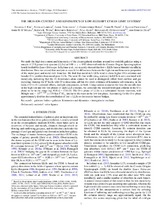The high-ion content and kinematics of low-redshift lyman limit systems
Date
2013Author
Fox, Andrew J.
Lehner, Nicholas
Dave, Romeel
Tumlinson, Jason
Howk, J. Christopher
Tripp, Todd M.
Prochaska, J. Xavier
O'Meara, John M.
Werk, Jessica K.
Bordoloi, Rongmon
Katz, Neal
Oppenheimer, Benjamin D.
Metadata
Show full item recordAbstract
We study the high-ion content and kinematics of the circumgalactic medium around low-redshift galaxies using a sample of 23 Lyman limit systems (LLSs) at 0.08 < z < 0.93 observed with the Cosmic Origins Spectrograph on board the Hubble Space Telescope. In Lehner et al., we recently showed that low-z LLSs have a bimodal metallicity distribution. Here we extend that analysis to search for differences between the high-ion and kinematic properties of the metal-poor and metal-rich branches. We find that metal-rich LLSs tend to show higher O VI columns and broader O VI profiles than metal-poor LLSs. The total H I line width (Δv 90 statistic) in LLSs is not correlated with metallicity, indicating that the H I kinematics alone cannot be used to distinguish inflow from outflow and gas recycling. Among the 17 LLSs with O VI detections, all but two show evidence of kinematic sub-structure, in the form of O VI-H I centroid offsets, multiple components, or both. Using various scenarios for how the metallicities in the high-ion and low-ion phases of each LLS compare, we constrain the ionized hydrogen column in the O VI phase to lie in the range log N(H II) ~ 17.6-20. The O VI phase of LLSs is a substantial baryon reservoir, with M(high-ion) ~ 108.5-10.9 (r/150 kpc)2 M ☉, similar to the mass in the low-ion phase. Accounting for the O VI phase approximately doubles the contribution of low-z LLSs to the cosmic baryon budget.

